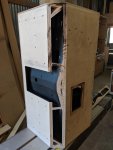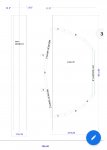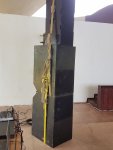Thanks again Carl that’s good to know.
Just got to get the angled sides plus top and bottom into the drawing.
Alternatively i go with the PM 90 CAD for CNC and have a local woodwork shop alter it to the same end but with the extra bracing.
Not ideal but possibly a beneficial compromise.
Rhys thank you for pointing out the creation time differences between the drawings as I believed the 60 thread and drawings were the latest.
I noted the differences and benefits and wish i had the skills to add the side, top & bottom differences to the CAD for CNC, even better would be if i had just missed it in the drawing but again thank you for the clarification.
A lot of thought, time & group attention went into this box so i would just like to show it & all involved the respect to get the best iteration of it i can, if possible as a flatpack without the need to alter it.
Hi Rodger,
Sorry not to notice your plight with my drawings until now! I think I could have saved you a lot of headaches here.
One thing I did not really mention in my posts about the drawings that I have mad is the story of the struggle to get to a single unified design. When I embarked on the quest to create a set of workable drawings, there were about three different versions of the drawings, all with slightly different measurement. Some had all of the parts dimension ed, others (namely Peter's) just had the critical parameters for the design.
You've been astute to notice that the final drawings resemble the 90 degree version that peter came up with after the fact. However, you seem to have missed some of the discussion that was going on with that design at the time. Peter's goal (at least as I understood it) was to create a fleet of cabinets that were largely identical with simply a difference in the horn used on the compression driver. Others (I want to say Don/Mark but I don't remember without re-reading everything) came up with the idea of having an interchangeable horn baffle, a completely trapezoidal cabinet, and several other things. As a community, we discussed the balance to be struck between thinner plywood and more bracing, how the 12" throat should be constructed, and many other things.
And so, in the summer of 2015, I set about on creating my version of the cabinet with the express idea of having it be easily mass producible. I took the large number of ideas and cut out the parts for the better part of a dozen boxes. I learned how CNC routing worked, what tolerances were necessary, and what was possible in the available materials. Anything that couldn't easily be done with a table saw and a CNC router and a single 1/4" end mill were scrapped from the design. This lead to many specific changes you will see in my cabinet, such as the lack of rear angles, a single CNC tool pass design, and baffles that were all sandwiched between two main outer pieces. I did my best to leave in flexibility for individual choices as far as handles, flyware, and connector types. I came up with a solution to the problems inherent to putting a grille on the cabinet face with the narrow cabinet width and such a wide horn. It was extremely fun, frustrating, and expensive. The process took two years and
several thousand dollars of R&D/prototyping. Then the maker space that I was using for my tooling went under, and I've been unable (and unwilling) to invest in new tooling to produce them since then. Anything I build today is designed with these principles in mind, but ultimately I ensure that it's all build able by hand with a table saw and router table. Perhaps this is a bit off topic, but I wanted you to know that I identify with losing access to your tooling.
I say all this to say that the drawings that I produced were my best attempt at compiling all of the knowledge we had gained up until that point and, for all intents and purposes,
the drawings I produced are the PM60 drawings. The original pdfs that you keep pointing to aren't final design plans. They are the working drawings that were used at the time, and the boxes as they exist are
all different from those drawings. I sifted through all of the information available to find the critical design parameters from Peter's drawings, Don's drawings, Mark's drawings, all of the posts, and several personal emails you aren't privy to. My drawings were created using parametric CAD software to solve for the exact dimensions of the only part that isn't clearly defined - the back baffle. In this process, I took the liberty to round the baffle dimensions to their nearest whole millimeter so that the precision required for people who built the box by hand would be less daunting and not needlessly verbose. I made sure to keep the internal volumes and horn length/areas as close as possible to Peter Morris's intent, and I think avoided screwing anything up too bad acoustically or mechanically. The end result is what could easily be made into a fleet of boxes with interchangeable horns. If you want to cut off the rear corners - you can! I did my best to let you create the perfect box by modifying my drawings, or just get a "greatest hits" of the thread if you chose not to.
In conclusion, I think you've wholly misunderstood the drawings available and what they were intended to represent. I tried my best to resolve this with the drawings I posed, but clearly I left out some context in my posts regarding them and their intent. I was thinking in the context of the PM60/90 community at the time, and not the people who would stumble upon it in the future after I stopped paying a lot of attention to it. I wish you the best of luck in creating whatever version makes you happy, and I hope to see lots of pictures of your success.



